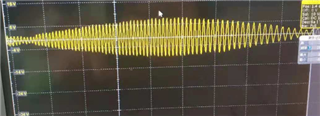
Hello, I want to use nrf52832 to output waveforms as shown above.
Using the Demo1 example in D: Lianxi nordic nRF5_SDK_12.2.0_f012efa examples peripheral pwm_driver, we want to change the frequency output, from large to small, and then from small to large free automatic loop output.
Let's take a look. What's wrong with the frequency? Thank you.
static void demo1_handler(nrf_drv_pwm_evt_type_t event_type)
{
uint32_t err_code;
if (event_type == NRF_DRV_PWM_EVT_FINISHED)
{
m_demo1_top += 100;
if(m_demo1_top>=10000)
{
m_demo1_top=0;
}
}
}
static void demo1(void)
{
NRF_LOG_INFO("Demo 1\r\n");
/*
* This demo plays back a sequence with different values for individual
* channels (LED 1 - LED 4). Only four values are used (one per channel).
* Every time the values are loaded into the compare registers, they are
* updated in the provided event handler. The values are updated in such
* a way that increase and decrease of the light intensity can be observed
* continuously on succeeding channels (one second per channel).
*/
uint32_t err_code;
nrf_drv_pwm_config_t const config0 =
{
.output_pins =
{
25 | NRF_DRV_PWM_PIN_INVERTED, // channel 0
//BSP_LED_1 | NRF_DRV_PWM_PIN_INVERTED, // channel 1
//BSP_LED_3 | NRF_DRV_PWM_PIN_INVERTED, // channel 2
//BSP_LED_2 | NRF_DRV_PWM_PIN_INVERTED // channel 3
},
.irq_priority = APP_IRQ_PRIORITY_LOWEST,
.base_clock = NRF_PWM_CLK_1MHz,
.count_mode = NRF_PWM_MODE_UP,
.top_value = m_demo1_top,
.load_mode = NRF_PWM_LOAD_INDIVIDUAL,
.step_mode = NRF_PWM_STEP_AUTO
};
err_code = nrf_drv_pwm_init(&m_pwm0, &config0, demo1_handler);
APP_ERROR_CHECK(err_code);
m_used |= USED_PWM(0);
m_demo1_seq_values.channel_0 = 0;
// m_demo1_seq_values.channel_1 = 0;
// m_demo1_seq_values.channel_2 = 0;
// m_demo1_seq_values.channel_3 = 0;
m_demo1_phase = 0;
nrf_drv_pwm_simple_playback(&m_pwm0, &m_demo1_seq, 1,
NRF_DRV_PWM_FLAG_LOOP);
}


